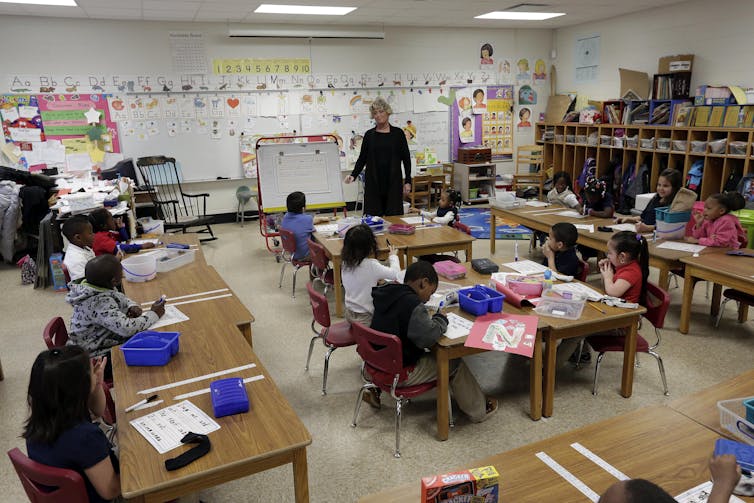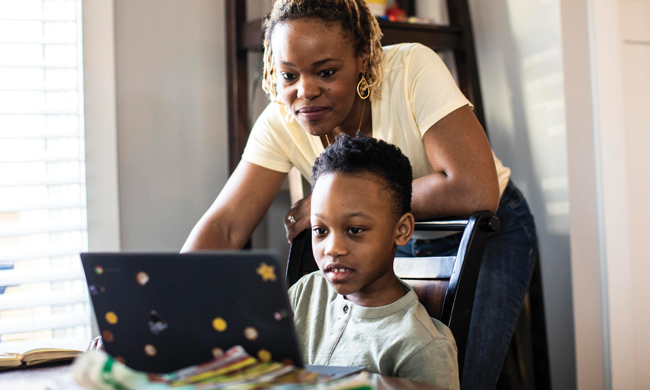child education
Poor teacher training partly to blame for stalled engineering diversity goals

Lisa Bosman, Purdue University
Diversifying the science, technology, engineering and math fields has long been a top priority of many universities and tech companies. It’s also a goal of the National Science Foundation, the biggest funder of university-led research and development in the U.S.
But in the field of engineering, at least, there hasn’t been a lot of progress in diversifying the academic pipeline beyond white men.
The share of engineering bachelor’s degrees awarded to Black students has barely budged over the past decade. Women and Hispanic students fared better, but their respective percentages are still well below their shares of the population as a whole. The shares of engineering professors who are Black or Hispanic are also little changed and remain in the low single digits.
Many reasons have been cited for this lack of progress, including stereotypes, lack of exposure, limited role models and the recent backlash against so-called woke policies that emphasize diverse hiring policies. But, as a scholar of STEM education accessibility, I believe there’s another culprit: poorly prepared professors. Unlike the other challenges, it happens to be a much easier problem for universities themselves to remedy.
Some progress – but not a lot
A quick look at the numbers shows there hasn’t been much to show for all the efforts to improve diversity of the engineering field.
For example, in 2011, 4.2% of engineering bachelor’s degrees were awarded to African American students. A decade later, 4.7% of degrees went to African American students.
Progress was better for women and Hispanic students, but the numbers are still far from proportional to demographics. In 2011, Hispanic students earned 8.5% of engineering degrees. That rose to 13.6% in 2021 – versus the group’s 20% share of the U.S. population.
Women similarly saw gains over the years, going from 18% to 24%. But 6 percentage points in 10 years doesn’t look as good when you consider that women make up over half of the population.
The situation is worse when you look at the share who become professors. In 2020, 2.5% of engineering professors were African American, the same share as 10 years earlier. The share of Hispanic engineering professors edged up to 3.9% from 3.7%.
Women fared slightly better, rising to 18.6% from 13.8%, but as noted, that’s still a pretty poor result from all those efforts to diversity the academy.
More broadly, there’s a deeper problem in engineering schools. Just 56% of engineering students complete their bachelor’s degree in six years, according to a 2021 report by the American Society for Engineering Education. That compares with 64% for all fields. A National Science Foundation survey from the same year found that only 65% of science and engineering college graduates were working in a field related to their degree.
In other words, roughly a third of engineering students aren’t getting their degrees, and among those who do, around a third are switching careers – despite investing a lot of money on their education. While there’s limited data available on women or specific racial groups, I don’t think I’m going out on a limb to argue that the numbers for them look even worse.
Engineering teachers lack much teacher training
Among the reasons cited for this, I believe that the roles of teaching and learning haven’t received enough attention.
A growing body of research suggests that the quality of teaching needs to improve to reverse trends of lower graduation rates and properly teach an increasingly diverse student body. And I believe this is especially true in STEM disciplines like engineering.
Engineering professors commonly have training in advanced technical areas, but few receive training in teaching and learning. This challenge of poor teaching preparedness is not limited to the engineering discipline, but the consequences are much worse, especially given the push to diversify STEM.
Effective teaching enhances retention and completion rates by promoting better understanding of the material and creating more student involvement in the learning process. When students are actively engaged, supported and motivated to learn, they are more likely to persist and complete their educational goals.
Teacher training for universities is starkly different than K-12 training. Most school districts require that teachers have a four-year bachelor’s degree in teacher education. The focus is less on content and more on implementing effective teaching practices. K-12 training includes lesson planning, differentiated instruction and best practices for classroom management. There is also often a strong emphasis on social, emotional and behavioral well-being.
Although some engineering doctoral students might gain teaching exposure through a graduate teaching assistantship, this experience is commonly limited to grading assignments and rarely includes course design and development.
To teach as a professor in colleges and universities, most accreditation boards simply require a minimum of 18 graduate credits – or about two semesters – in the topic area. Here, the focus is strictly on research content. No prior teaching experience or training is required.
As a result, newly minted doctoral graduates are thrown into the lion’s den of teaching unprepared. If they are lucky, they are provided with the latest available syllabus. However, new professors are typically unprepared to accommodate students with disabilities, teach Black and Hispanic students, work with remedial students or navigate sensitive topics. They are generally anxious about teaching.
The field of K-12 teacher education has strategies to deal with these challenges. Continuing education and ongoing professional development keep both experienced and inexperienced teachers up to date on inclusive teaching practices. These can include sharing gender pronouns, ensuring media is accessible, using inclusive language and offering diverse perspectives in teaching resources. And yet, keeping up with these changes can be daunting for new professors.
Teaching teachers to teach
But there is a solution: treating college-level teaching as a professional development opportunity.
Most colleges and universities offer professional development training for professors and other instructors who want to opt in to teacher training, but the programs often have limited scope and responsibility at a level to make a substantial positive impact on student learning and engagement.
One way to change this is to invest in Scholarship of Teaching and Learning programs. This is a scholarly approach in which educators systematically study their teaching practices, student learning outcomes and the effectiveness of various teaching methods and strategies.
At Purdue University, we created a Scholarship of Teaching and Learning Accelerator program to help engineering graduate students around the world improve their teaching methods and share what they learned with others. In 2024, we published a peer-reviewed article that reports the process and what we learned.
By providing comprehensive professional development opportunities tailored to the needs of engineering instructors, institutions can support their ongoing growth and development as effective educators, ultimately enhancing the quality of engineering education and preparing students for success in their future career.
And in turn, better-trained teachers will be better equipped to support students from diverse backgrounds and help those traditionally underrepresented in STEM.
Lisa Bosman, Associate Professor of Technology Leadership and Innovation, Purdue University
This article is republished from The Conversation under a Creative Commons license. Read the original article.
The Bridge is a section of the STM Daily News Blog meant for diversity, offering real news stories about bona fide community efforts to perpetuate a greater good. The purpose of The Bridge is to connect the divides that separate us, fostering understanding and empathy among different groups. By highlighting positive initiatives and inspirational actions, The Bridge aims to create a sense of unity and shared purpose. This section brings to light stories of individuals and organizations working tirelessly to promote inclusivity, equality, and mutual respect. Through these narratives, readers are encouraged to appreciate the richness of diverse perspectives and to participate actively in building stronger, more cohesive communities.
https://stmdailynews.com/the-bridge
Discover more from Daily News
Subscribe to get the latest posts sent to your email.
Blog
The Substitute Teacher Who Wanted Blueprints of Our House
A fifth-grade assignment took a strange turn when a substitute teacher asked students to draw schematics of their homes. What followed — a wildly fictional floor plan and a priceless reaction from my mom — turned into one of my funniest childhood memories.
Last Updated on December 8, 2025 by Daily News Staff
The Substitute Teacher Who Wanted Blueprints of Our House
Elementary school memories tend to blend together — cafeteria pizza, playground arguments, the eternal struggle of times tables — but every once in a while, something happens that sticks with you for life. For me, that moment came in the fifth grade during a week when our regular teacher was out, and we cycled through substitute teachers like we were testing models for durability. By midweek, in walked a substitute with a mysterious, slightly intense energy — the kind of vibe that suggested he either meditated at dawn or worked a graveyard shift doing something he couldn’t talk about. We settled into our seats, expecting worksheets or quiet reading time. But nope. He had other plans. “Today,” he announced, “we’re going to draw schematics of our houses.” Schematics. Not drawings. Not little houses with smoke coming out of the chimney. Actual blueprint-style schematics. He wanted the layout of our bedrooms, our parents’ rooms, and where the pets slept. Every detail. Now, to be fair, Highlights Magazine did have a feature that month teaching kids how to draw floor plans. So maybe he was just a bit overenthusiastic about cross-curricular learning. Or maybe — and this is my completely rhetorical adult theory — he worked the graveyard shift as a cat burglar gathering intel between heists. Just moonlighting between blueprints. While the rest of the class tried their best to recreate their actual homes, my imagination sprinted in a totally different direction. The house I drew had:- A massive master bedroom with an oversized bathroom for my parents
- Separate bedrooms for us kids on the opposite side of the house
- A kitchen placed right in the center like a command center
- And the dog — the true VIP — had a luxurious two-story doghouse
Enjoy this story?
Check out more nostalgic and humorous stories on STM Daily News and be sure to sign up for our newsletter!Our Lifestyle section on STM Daily News is a hub of inspiration and practical information, offering a range of articles that touch on various aspects of daily life. From tips on family finances to guides for maintaining health and wellness, we strive to empower our readers with knowledge and resources to enhance their lifestyles. Whether you’re seeking outdoor activity ideas, fashion trends, or travel recommendations, our lifestyle section has got you covered. Visit us today at https://stmdailynews.com/category/lifestyle/ and embark on a journey of discovery and self-improvement.
Discover more from Daily News
Subscribe to get the latest posts sent to your email.
Lifestyle
Preparing for the Future of Work: Tips to help teens choose a career path
Preparing for the Future of Work: American teens are optimistic about their careers despite concerns over AI’s impact. Many value internships and real-world experience over degrees, and are weighing passion against pay, seeking balance in their future career choices.
Last Updated on December 2, 2025 by Daily News Staff
Preparing for the Future of Work: Tips to help teens choose a career path
(Family Features) American teens are preparing for a workforce shaped by AI, new approaches to education and economic uncertainty. While challenges are real, optimism remains high.
In fact, 94% of teens said they are optimistic about their future careers, reflecting a strong sense of hope and ambition, according to research from Junior Achievement and Citizens. The two organizations have partnered for more than 18 years to advance financial empowerment nationwide, with the bank allocating funding and volunteer support, including more than $630,000 in 2025 to support financial empowerment programs that give people the confidence and tools they need to budget, save, invest and pursue their goals.
However, 57% of teens surveyed believe AI has negatively impacted their career outlook, raising concerns about job replacement and the need for new skills.
“Today’s teens face a rapidly changing world, from the rise of AI to shifts in education and careers,” said Susan LaMonica, chief human resources officer at Citizens. “The survey shows they know the importance of adaptability and continuous learning.”
To help teens build skills for emerging roles and navigate their futures, consider these tips from the experts at Junior Achievement, the world’s largest organization dedicated to giving young people the knowledge and skills they need to own their economic success, plan for their futures and make smart academic and economic choices.
Explore Internships
Success depends on more than credentials alone. Survey respondents believe networking (50%) and internships (41%) are keys to future success. What’s more, 56% believe real-world experience is more valuable than a four-year degree. Internships can provide that experience and allow students to test their interest in a field while building their professional networks, developing skills that can be applied to a range of career paths, identifying strengths and weaknesses and clarifying future goals.
Consider Post-High School Education
Teens’ perspectives on education reflect their uneasiness. Only 40% of teens surveyed believe a four-year degree is always a good investment. At the same time, about 6 in 10 believe a bachelor’s or graduate degree is still necessary for their chosen profession, which shows how complicated these decisions can be. While many careers require a college diploma, that isn’t the only path to career success. In addition to traditional four-year universities, consider alternate education paths such as trade schools or technical programs, apprenticeships, two-year degree programs or professional certifications if applicable to your career path.
Weigh Passion Against Pay
While most teens surveyed (63%) said they would prefer a good-paying job even if it comes with stress, many are weighing passion against pay as they explore career opportunities. In fact, some top industries in which teens plan to pursue a job include health care and life sciences (30%), arts and music (27%) and content creation and digital media (25%), further showcasing that willingness. Many students are also exploring less traditional routes to build security and opportunity, with 87% expecting to earn extra income through side hustles, gig work or social media content creation.
“The data illustrates how the stressors on young people are compounding year after year,” said Tim Greinert, president of Junior Achievement USA. “It also shows how resilient and savvy students are these days in terms of understanding the world around them and deciphering the best path to the future that’s best for them.”
To learn more about preparing for future success and find full survey results, visit JA.org/FutureOfWork.
Photo courtesy of Shutterstock
SOURCE:
STM Daily News is a vibrant news blog dedicated to sharing the brighter side of human experiences. Emphasizing positive, uplifting stories, the site focuses on delivering inspiring, informative, and well-researched content. With a commitment to accurate, fair, and responsible journalism, STM Daily News aims to foster a community of readers passionate about positive change and engaged in meaningful conversations. Join the movement and explore stories that celebrate the positive impacts shaping our world.
Discover more from Daily News
Subscribe to get the latest posts sent to your email.
Lifestyle
Tech Time: Technology-enabled devices for parents and children
Last Updated on November 3, 2025 by Daily News Staff
(Family Features) Encouraging a successful education for your kids while promoting fun after-school learning may never be easier than right now. From wearables to virtual reality headsets and beyond, the latest tech-enabled devices let families enhance classroom experiences while engaging in downtime together after the final school bell rings.
Find more gadgets to help families balance learning and pleasure this school year at qualcomm.com.
First Work Then Play
A practical choice, the Lenovo Duet 3 Chromebook is an ideal work and play device for a hyper-mobile student, delivering superior experiences with an 11-inch 2K near-borderless display. Faster connectivity options, all-day battery life and the powerful, fanless and efficient performance of the Snapdragon 7c Gen 2 Compute Platform ensure things get done. Thanks to the speedy, secure and simple-to-use Chrome OS, you can tackle tasks on this 2-in-1’s detachable keyboard with anti-pry, water-resistant keys then seamlessly switch to pleasure pursuits by folding into tablet mode.
Lightweight, Powerful Computing
Weighing in at less than 1.2kg, the convertible Acer Chromebook Spin 513 is not only light but also barely larger than a sheet of paper so it slips easily into any compact bag or backpack. Powered by the Snapdragon 7c Compute Platform, it delivers more than enough processing power, battery life and reliable connectivity to get you or your student through the day. A quick flip between laptop and tablet modes means it can be used to doodle, watch classroom instruction and learn on the go. Built-in cellular connectivity means the device seamlessly converts between 4G LTE and trusted Wi-Fi networks.
Wearable Connectivity
Powered by the Snapdragon Wear 2500 Platform, the Gabb Watch is a safe wearable phone for kids that does extra duty as a GPS tracker, phone and interactive smartwatch. The watch offers kid-friendly sweat and dirt resistance and enables GPS tracking, calling, voice and text messaging to help parents and kids stay connected. With a lock mode, safe zone location management and emergency notifications, it’s a smart first step toward independence for junior users.
Headset Hero
Designed from the ground up to drive advanced features, Snapdragon XR2 is the force behind the Meta Quest 2 headset’s freedom of movement and high-resolution display. This headset allows families to become completely immersed in the virtual reality applications and games played for maximum adventure experiences. Even better, hundreds of hit games, one-of-a-kind experiences and a growing community await users of this next-level hardware that’s both easy to set up and safe to use.
A Phone to Keep Everyone Connected
Choosing a phone means looking for the fastest speeds, highest resolution camera, loudest audio and boldest display.Powered by the latest Snapdragon 8 Gen 1 Mobile Platform processor, the motorola edge+ (2022) delivers. This industry-leading smartphone is a high-performance choice that brings unparalleled processing power on the industry’s fastest mobile platform, fueling cutting-edge 5G, AI, gaming, camera and Wi-Fi and Bluetooth technologies. What’s more, features like extended battery life and 512 GB of storage mean your phone is ready whenever you are.
Photo courtesy of Getty Images (Mom and Son)
SOURCE:
Qualcomm
Our Lifestyle section on STM Daily News is a hub of inspiration and practical information, offering a range of articles that touch on various aspects of daily life. From tips on family finances to guides for maintaining health and wellness, we strive to empower our readers with knowledge and resources to enhance their lifestyles. Whether you’re seeking outdoor activity ideas, fashion trends, or travel recommendations, our lifestyle section has got you covered. Visit us today at https://stmdailynews.com/category/lifestyle/ and embark on a journey of discovery and self-improvement.
Our Lifestyle section on STM Daily News is a hub of inspiration and practical information, offering a range of articles that touch on various aspects of daily life. From tips on family finances to guides for maintaining health and wellness, we strive to empower our readers with knowledge and resources to enhance their lifestyles. Whether you’re seeking outdoor activity ideas, fashion trends, or travel recommendations, our lifestyle section has got you covered. Visit us today at https://stmdailynews.com/category/lifestyle/ and embark on a journey of discovery and self-improvement.
Discover more from Daily News
Subscribe to get the latest posts sent to your email.

